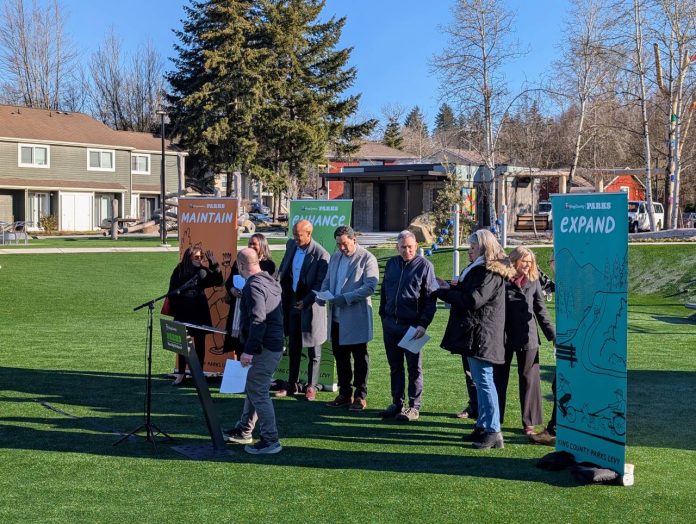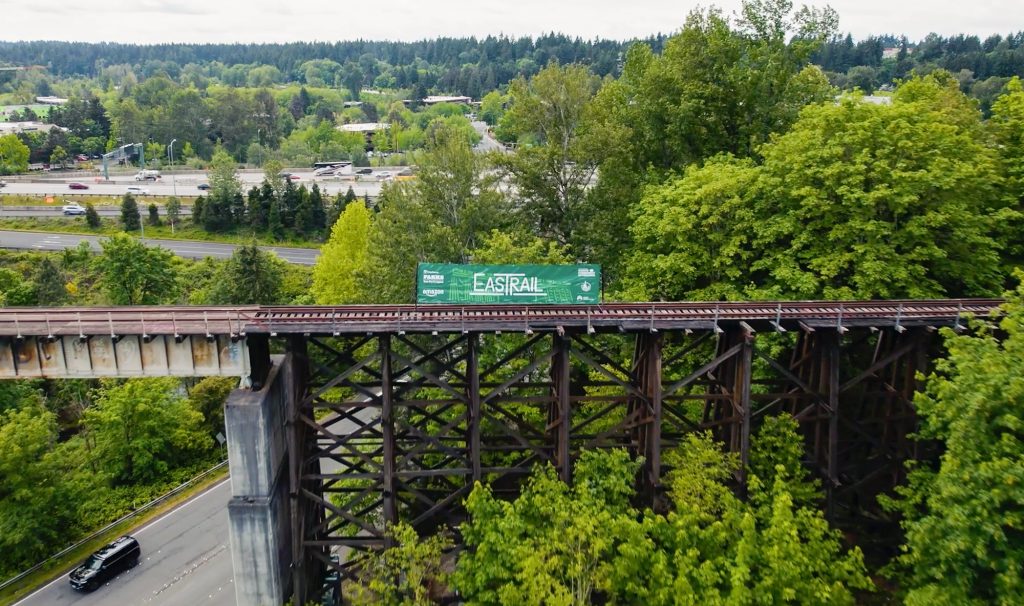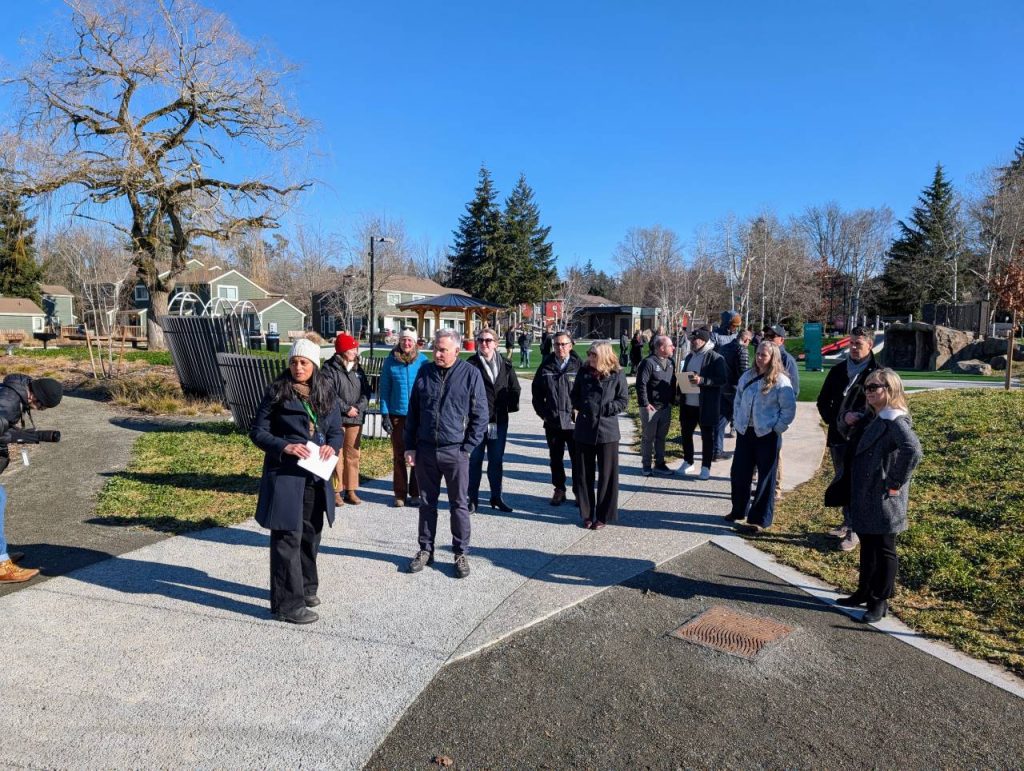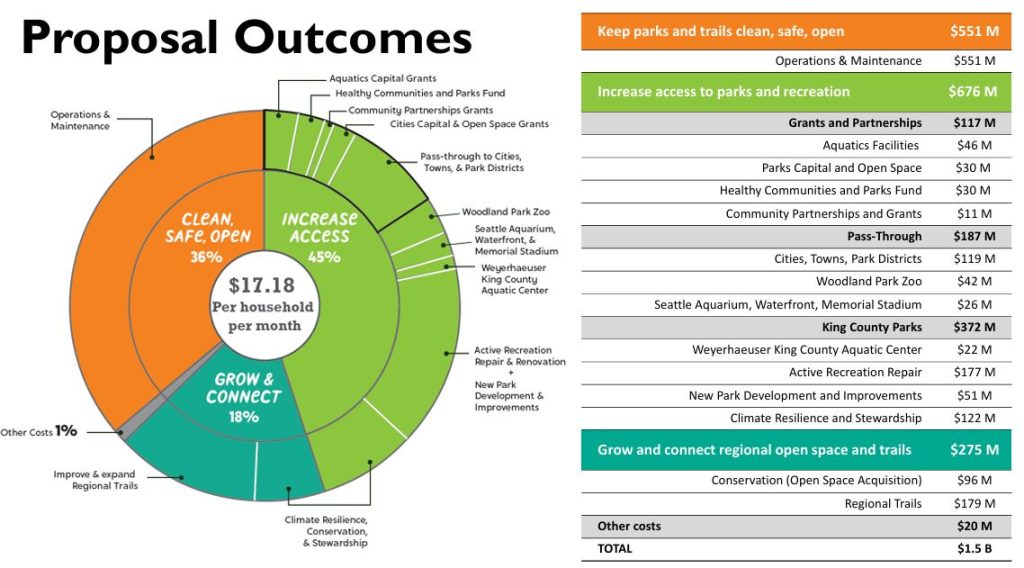
On Tuesday, King County Executive Dow Constantine announced his $1.52 billion proposal to renew the King County Parks Levy, which expires at year’s end. Accounting for about 85% of King County Parks’ budget, the levy has also funded major expansions of both parks and the regional trail system.
“The people of King County have renewed this parks levy every six years since it was established around two decades ago now,” Constantine said. “And I believe we have built one the nation’s premier networks of parks and trails, and they offer fun, healthy activities, teen programs, swimming, concerts, movies, hiking, bike rides, connecting the outdoors to each of us and each of us to one another in this most densely populated metropolis.”
The proposal’s expansion projects would include Lake to Sound Trail, Green River Trail, Soos Creek Trail, Eastrail, Interurban Trail, and a connector trail improving access to Eastrail from Gene Coulon Memorial Beach Park in Renton. It would also complete the design for a 1.7-mile connector between Eastrail and Lake to Sound Trail.

Joining Constantine at the rollout press event at Pathways Park in Seattle’s Bryant neighborhood was Seattle Mayor Bruce Harrell and King County Councilmembers Girmay Zahilay and Claudia Balducci. Harrell called the levy a great deal for Seattle, flagging educational programming funded in the levy.
“I’m pleased that this levy renewal — I have to be a little selfish here, because I’m the mayor of the city,” Harrell said. “I’m very pleased to see that the educational programs of the Seattle Aquarium, the Woodland Park Zoo and the Seattle Waterfront, among other assets in the city will be beneficiaries of this levy that the county has shown leadership on. So together, with the support of the King County voters, we are preserving, protecting and enhancing our public spaces so that, most importantly, generations of Seattleites can enjoy them.”
King County Executive Dow Constantine is at Pathways Park in northeast Seattle today to announce a park levy renewal campaign. The last county parks levy funded a major upgrade to Pathways Park, which borders the Burke-Gilman Trail.
— The Urbanist (@theurbanist.org) February 11, 2025 at 10:17 AM
[image or embed]
Zahilay noted how important park and open space access is for kids, especially in marginalized communities, sharing his own personal experience.
“When I was 13, my family actually moved up to Renton Avenue in South Hill, from South Seattle to Skyway. It was just a couple of miles south, but it felt like a completely different world to us. Suddenly, all the parks, playgrounds and community spaces that I had relied on as a kid vanished. There was no community center, no gathering spaces, very few sidewalks and bike paths where we could play outside. While most kids looked forward to summer, my siblings and I dreaded it, because for us, summer months meant sitting indoors, watching TV, looking outside the window, losing critical moments of our childhood, and all of this because of a lack of public investment. That experience shaped me.”
Balducci emphasized the the levy’s investments in serving disabled kids with ADA-friendly playgrounds, Marymoor Park upgrades (which will pair nicely with the Downtown Redmond light rail expansion bringing trains to its doorstep in May) and regional trail improvements.
“I’m very thrilled that this levy continues to expand our regional trails,” Balducci said. “We have an outstanding regional trail network, and it’s going to get even better and support access to transportation options that are healthy and sustainable and fun.”
King County Parks is one of the nation’s largest metropolitan park agencies, stewarding more than 250 parks, more than 185 miles of regional trails, more than 215 miles of backcountry trails, and more than 32,000 acres of open space, according to the County.
The venue for the announcement was Pathways Park, which received a $1.3 million investment from the current levy to overhaul the facilities and add a new playground that surpasses Americans with Disabilities Act (ADA) standards. “It’s a successful model Executive Constantine wants to replicate throughout King County, particularly in underserved communities,” the County press release said. The Bryant neighborhood park also improved access to the Burke-Gilman Trail with a connector trail that also offers a shortcut to Seattle Children’s Hospital.
Meanwhile, some Bryant residents are fighting against the “One Seattle” proposal of expanding housing opportunities in the area and having new neighbors around with easy access to these regional park facilities.

“As a mom of a kid who couldn’t engage with every play structure in the world, this place is fantastic because it is just it is a testament to all kids playing together, regardless of their abilities,” Balducci said. “It’s not a special place for certain kids. It is a place for all kids to play together, and that is just a wonderful testament to what we do with our parks and open spaces.”
The creation of parks levy help build up the park system rather than shrinking, as it faces financial struggled two decades ago, Balducci noted.
“We have one of the greatest park systems in the entire country, if not the world,” Balducci said. “It is a truly amazing place that we have here, and that’s not by accident. That is because our residents, our voters, have prioritized making it so. Around the turn of the last century, that was not the case. We were in very bad financial straits with regard to our park system. And our parks director at the time left saying, ‘I didn’t get into this business to shut down parks. I got into this business to open up parks.'”
The levy rate would be slightly higher than under the current levy, which is set to raise $810 million over six years. While the current levy charges about 19 cents per $1,000 assessed property value, the renewed levy would cost 24 cents per $1,000, which would cost the owner of a median-valued home about $17.18 per month, about $3.44 more per month than they currently pay, the County said. The 2019 levy passed with more than 70% of the county vote.

According to the County’s breakdown, 45% of the proposed levy investments will go to increase access to parks, open space, and programming, 36% would go to operations and maintenance, and 18% would be dedicated to improving and expanding regional trails. The County also highlighted cleaning and safety programs in its highlights:
- Increasing capacity to keep parks and trails clean, safe, and open
- New and improved amenities, including upgrades to Marymoor Park, the Weyerhaeuser King County Aquatic Center, and regional ballfields.
- Funding new projects, such as Skyway’s first community center, additional off-leash dog areas, and a new nature park in east Federal Way.
- A first-ever climate response fund, available for features like cooling stations, splash pads, and energy-efficient facilities to help communities adapt to extreme weather.
- Increased funding for local cities and community organizations, ensuring equitable access to green spaces.
Constantine told The Urbanist that the levy is part of the County’s strategy to persist with or without help from the federal government. Since Trump took office for a second time, his administration has been frantically freezing funds and trying to cancel Congressional appropriations, sowing chaos. Some parks programs may have normally qualified for federal matching grants, but that may be out the window for the next four years.
“Everything is at risk from instability at the federal level,” Constantine said. “Our region needs to be resilient and to hew to our values and to see this through. We’re not going to abandon our commitment to parks and natural areas, because what the federal government does, nor to transit, nor do any of the other things that matter to us. So we are fortunate and maybe almost unique in the United States in having a strong economy and a constituency that really believes in these things, and so I’m absolutely confident that we can see it through to the other side. I would prefer to have the federal government as a partner, but we will persist regardless.”
The County’s timeline anticipates county council hearings over the coming months ahead of April legislative action to place the levy on the primary ballot in August. That’s not a lot of time for council review for a $1.5 billion proposal, with many councilmembers likely eager to put their own stamp on the big opportunity for countywide parks investments.
Doug Trumm is publisher of The Urbanist. An Urbanist writer since 2015, he dreams of pedestrian streets, bus lanes, and a mass-timber building spree to end our housing crisis. He graduated from the Evans School of Public Policy and Governance at the University of Washington in 2019. He lives in Seattle's Fremont neighborhood and loves to explore the city by foot and by bike.


